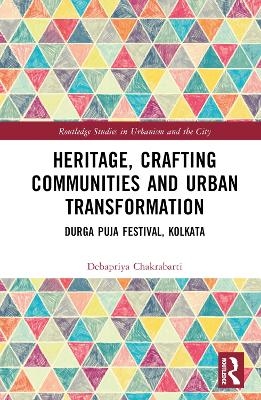
Heritage, Crafting Communities and Urban Transformation
Routledge (Verlag)
978-1-032-37647-9 (ISBN)
The book delves into the complexities of caste, gender, class, and political identities and affiliations associated with the multiple factors of inclusion and exclusion particularly in the case of access to infrastructure in informal settlements in urban areas with an added productive function. This book is about how this historic inner-city, situated, religious idol-crafting community is transforming due to factors including access to physical and social infrastructure, local governance policies, sociopolitical hierarchies, and complexities of informal tenure. Drawing on sociocultural norms, and values of idol-crafting practices, it documents, analyses, and presents the networks and relations of the neighbourhood through a spatial and material lens. Findings contribute to understanding how traditional practices of a crafting community are adapting, appropriating, producing, and reshaping informal spaces in Kumartuli.
The book is aimed at academic audiences across the world researching creative industries, Kolkata’s regeneration agenda, and cultural tourism. It will be of interest to the wide disciplines of Urban Studies, Development Studies, Architecture and Planning, and Culture and Tourism Studies.
Debapriya Chakrabarti is a researcher in the field of urban studies at the Manchester Institute of Innovation Research and teaches at the Manchester School of Architecture. She is trained as an architect and urban planner. Her research interests lie at the intersection of urban regeneration, cultural industries, and place-based development policies.
Lists Of FiguresList Of TablesPrefaceAcknowledgement Chapter 1 Durga Puja, Kumartuli and KolkataFestival, religion, culture, and politicsColonial Calcutta’s Durga PujaBarowari brought inclusivityCultural heritage, informality, and idol-crafting practiceStructure of the bookChapter 2 Crafts and Practitioners Idol crafting practice and sustainability Kumbhakar caste relates to pottery The Caste-based potters’ para Interwoven communities of practice Emerging actors and shiftsChapter 3 The spaces of production The neighbourhood Streetscapes, alleys, riverfront The conventional workshop-residence The ‘factory-shed’ workshopChapter 4 Seasonal adaptations and everyday negotiation The preparation phase Adaptation, accommodations, and negotiationsInfrastructural disrepair and hopelessnessSocial cohesion, coordination, and competitionWill Kumartuli continue to thrive?Chapter 5 Complexities The redevelopment plan Reaction and resistance to the KMDA plan Tenure and ownership: realities Informality in the heritageChapter 6 The emerging and diverging spaces of production Kumartuli on a regular day Changing spaces: Repurposed workshop Agency and new typologies Appropriation and socio-spatial relations Spatial flexibility and reparation in a Kolkata bastiChapter 7 Kumartuli’s future? Kumartuli’s present Reparations and public services Contributions and implications of this research Recommendations Personal reflectionMethodological Appendix: Research Strategies Practice Theory research method FieldworkGlossary of Bengali wordsIndex
| Erscheinungsdatum | 10.10.2023 |
|---|---|
| Reihe/Serie | Routledge Studies in Urbanism and the City |
| Zusatzinfo | 4 Tables, black and white; 12 Line drawings, black and white; 27 Halftones, black and white; 39 Illustrations, black and white |
| Verlagsort | London |
| Sprache | englisch |
| Maße | 156 x 234 mm |
| Gewicht | 453 g |
| Themenwelt | Geisteswissenschaften ► Geschichte |
| Naturwissenschaften ► Geowissenschaften ► Geografie / Kartografie | |
| Sozialwissenschaften ► Soziologie | |
| ISBN-10 | 1-032-37647-3 / 1032376473 |
| ISBN-13 | 978-1-032-37647-9 / 9781032376479 |
| Zustand | Neuware |
| Informationen gemäß Produktsicherheitsverordnung (GPSR) | |
| Haben Sie eine Frage zum Produkt? |
aus dem Bereich


